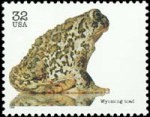Happy Leap Year!
Species featured: European Tree Frog, Northern Leopard Frog, Strawberry Poison-Dart Frog, American Bullfrog
This first day cover is by Tom O’Hagan of S &T Cachets. The illustration is from an trade card for Ayers Ague Cure, which claimed to cure fever and chills. The stamp (Scott 2950) was issued in 1995 for the 150th Anniversary of Florida Statehood.
Ayer’s Ague Cure was one of a number of “medicines” manufactured by the J.C. Ayer’s Co. during the 19th century. The Ague Cure, which claimed to cure all “afflictions which arise from milarious, marsh, or miasmatic poisons”, was made of alcohol and chincona bark (quinine) and so probably actually had some effect. Ayer’s other products included Ayer’s Cherry Pectoral (which purportedly a cure for coughs and contained either morphine or heroin), Sasparilla (which claimed to cure jaundice, syphilis, ringworm, boils, ulcers, “female weaknesses” and rheumatism), and Hair Tonic. The Ayer’s Almanac, discussed here, is worth taking a look at.
This cover, postmarked May 13, 1933, Navy Yard, Boston, MA, is from the U.S.S. Du Pont (DD-152). Named for Rear Admiral Samuel Francis Du Pont (yes, he was one of those Du Ponts), the destroyer was launched in 1918 and (apparently these are different things) commissioned in 1919. At the time this cover was mailed, the Du Pont was operating out of Boston as a training vessel. With the outbreak of World War II, she was recommissioned (for the second or third time) and became part of the Neutrality Patrol; eventually, she escorted convoys across the Atlantic and was one of the ships that brought casualties back from Normandy. She was decommissioned for the last time in 1946 and sold in 1947.
Marianne Moore (1887-1972), an American poet, is perhaps most famous for a poem entitled “Poetry” , which begins with some of the best lines in American Literature:
I, too, dislike it: there are things that are important
beyond all this fiddle.
Reading it, however, with a perfect contempt for it,
one discovers that there is in
it after all, a place for the genuine.
Later, we find the lines that occasion these cachets:
One must make a distinction
however: when dragged into prominence by half
poets,
the result is not poetry,
nor till the autocrats among us can be
“literalists of
the imagination” – above
insolence and triviality and can presentfor inspection, imaginary gardens with real toads
in them, shall we have
it.
Cachet Maker: Steve Wilson
The theme of the 1984 Louisiana World Expo was “The World of Rivers: Fresh Water as a Source of Life.” The fair didn’t do so well–bankruptcy was declared before it ended–but it was the occasion of this U.S. stamp. Birds on this stamp include the Louisiana Heron, the Anhinga, and the Canada Goose.
 Scott No.: 3105g
Scott No.: 3105g
Date of Issue: October 2, 1996
City of Issue: San Diego, CA
Species: Wyoming Toad
Set: Engangered Species (15 stamps)
According to the U.S. Fish and Wildlife Service, the Wyoming Toad (Bufi baxteri), which was found only in Albany County, Wyoming, is a “glacial relict” which inhabited ponds and flood plains. It was abundant through the 1970s and placed on the endangered list in 1984. A number of zoos now have breeding programs. The Wyoming toad grows to be about 2.2 inches long and is covered in warts.